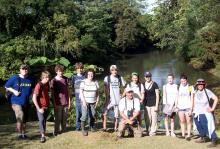Faculty’s Summer Trips Enhance Classroom Learning

Whether it was a long trek to Barbados or just a short hike to the U-M campus, the following eight faculty members spent time this summer soaking up experiences to share with their students.
Nadine Hall
History, Diversity, Admissions
This summer Nadine participated in a Gilder Lehrman Teacher Seminar at the University of West Indies in Barbados. The Gilder Lehrman Institute is renowned for its scholarly seminars for K-12 educators. The one-week competitive application seminar was entitled “Slavery and the Slave Trade in the Caribbean,” and explored the slave trade as it developed in the Americas. Directed by Philip Morgan, professor of history at Johns Hopkins University, the seminar included a review of primary source documents by leading scholars in the field and practical resources and strategies to take back to the classroom.
Jill Johnson
Mathematics
Jill was awarded a fully funded fellowship to Columbia University’s Klingenstein Summer Institute, the only institute of its kind devoted entirely to the study of independent education and to the development of leaders in independent schools. The program, held at the Institute at The Lawrenceville School in New Jersey, focused on curriculum development, diversity, and school structure and the ways in which innovation in these areas can improve student comprehension.

Rob Kinnaird
Fine & Performing Arts
Among many other activities this summer, Rob Kinnaird spent a week salmon fishing on the Alagnak River in southwest Alaska with his father and brother. They stayed at a camp called Angler’s Alibi, which was about 250 miles from the nearest road, and had an electrified perimeter to protect them from the large number of bears in the area.

Elaine Moffat, Lisa Ortiz & Kevin Olson
Spanish
Elaine, Lisa and Kevin traveled to Costa Rica this summer with eight upper school students. The group visited many destinations, including an organic pineapple farm, an ecological farm, a Maleku Indigenous Reserve, a school, the active volcano at Arenal, different tropical rainforests, a cloud forest, and the Pacific coast. Their whirlwind of activity included dancing, hiking, swimming, zip lining, horseback riding, making tortillas, visiting natural hot springs, and learning about bats and chocolate. The cost of the trip helped sponsor a student at the local school in Sarapiquí. The students also brought a donation of school supplies to the Costa Rican school.

Ann Novak
Science
On a visit to Tucson, Ariz. this summer, Ann visited Biosphere 2 to learn more about sustainable closed systems and water. During the early 1990s eight Biospherians were sealed inside the glass enclosure for two years, the purpose of which was to explore the complex web of interactions between humans, farming, and technology with the rest of nature. The project also explored the possible use of closed biospheres in space colonization.
Back home at Greenhills, the stream project has evolved over the past several years. In addition to measuring water quality of the stream that runs behind the school and chipping trails, students this year will collect water quality data at nearby Fleming Creek and work on a global project to help bring fresh clean water to a community in a third world country.
Julie Smith
Science
Julie spent the summer working in Dr. Linda Samuelson’s lab at the University of Michigan. Dr. Samuelson’s research program is focused on the development and function of the gastrointestinal system, with particular focus on mechanisms regulating epithelial cell identity. In the stomach and intestine, stem cells continually form and replenish the epithelium throughout the lifespan of the organism. Julie did PCR genotyping, immuno-fluorescent staining, tissue embedding, primer reconstitution and analysis of the lab’s PCR assay protocol documents.
She says, “I learned so much and had a great time being involved in an active research lab. I’m excited to incorporate what I learned over the summer into my Cellular and Molecular Biology class this year.”





